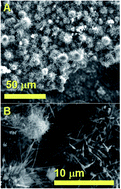Observation of local changes of “carbon-to-metal ratio” in the growth mechanism of carbon nanostructures grown from FePd-based and Fe3C catalysts by pyrolysis of ferrocene and dichlorocyclooctadiene-palladium mixtures: the crucial role of Cl†
Abstract
One of the major challenges in the field of carbon nanomaterials consists of understanding their growth mechanism dynamics. Recent reports have shown preliminary steady state chemical vapour deposition (CVD) experiments for the encapsulation of FePd-based alloys inside carbon-based nanostructures. However, very little is known about their growth mechanism dynamics. Here we investigate the possible presence of local changes of “carbon-to-metal ratio” in the growth mechanism of carbon nanostructures grown from FePd-based and Fe3C catalyst-particles by steady state CVD and viscous-boundary-layer chemical vapour synthesis (CVS) experiments involving the pyrolysis of ferrocene/dichlorocyclooctadiene-palladium mixtures and of ferrocene/dichlorobenzene mixtures. In the first case, we demonstrate the observation of an unusual growth mechanism in which a direct transition from a spherically elongated carbon-onion-like (CNOs-like) morphology (low carbon-to-metal ratio condition) to a carbon fiber-like morphology (high carbon-to-metal ratio condition) is present within the same carbon structure. We attribute such transitions to the variation of the Cl-radicals concentration during the pyrolysis process, which implies a variation in the local “carbon to metal ratio” parameter. The reported mechanism is then compared in detail with that of Fe3C filled CNTs obtained by CVD of ferrocene/dichlorobenzene mixtures and with those reported in the literature for other transition metal catalyst systems. In contrast, when a viscous boundary layer is created between the pyrolysed ferrocene/dichlorocyclooctadiene-palladium precursors and a rough surface, radial CNT structures filled with large quantities of both FePd3 and Fe3C crystals are found as major reaction products. The presence of filled-CNOs within the radial structures-core (resulting from the homogeneous nucleation of particles in the viscous boundary layer) suggests that fluctuations in the local “carbon-to-metal ratio” are also present in this type of mechanism. The morphological, cross-sectional and structural properties of the obtained carbon structures are analyzed in detail by SEM, TEM, STEM, HRTEM, ED and X-ray diffraction.



 Please wait while we load your content...
Please wait while we load your content...